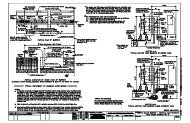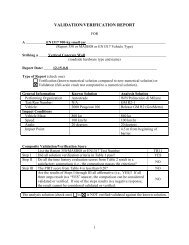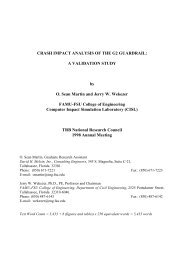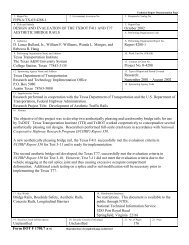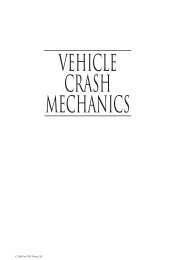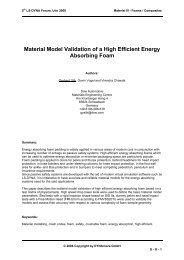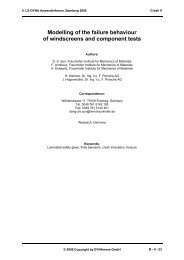Vehicle Crashworthiness and Occupant Protection - Chapter 3
Vehicle Crashworthiness and Occupant Protection - Chapter 3
Vehicle Crashworthiness and Occupant Protection - Chapter 3
You also want an ePaper? Increase the reach of your titles
YUMPU automatically turns print PDFs into web optimized ePapers that Google loves.
Finite Element Analytical Techniques<br />
<strong>and</strong> Applications to Structural Design<br />
showing that a safety factor of 10 with respect to the stability limit should not<br />
cause any appreciable loss of accuracy due to penetrations intrinsically allowed<br />
by the nature of the contact algorithm.<br />
The main problems in contact algorithms originate in the node-to-segment nature<br />
of the model definition, as well as in the search algorithms that define which<br />
nodes are in contact with which segments. In particular, treating node-to-segment<br />
conditions only leads to a systematic failure of detecting edge-to-edge or edgeto-segment<br />
penetrations. Early search algorithms detected a nearest master node<br />
for each slave node <strong>and</strong> selected a single nearest master segment from all segments<br />
connected to the nearest master node. This is an algorithm that works very well<br />
for the simulation of the contact of two smooth convex surfaces, but fails in many<br />
situations that occur in the high curvature failure modes of an automotive structure.<br />
In particular, multiple impacts may occur simultaneously, <strong>and</strong> high curvatures in<br />
the mesh, as well as irregular meshes, may easily lead to the detection of a wrong<br />
neighbor segment, allowing numerous penetrations to remain undetected.<br />
Additionally, the search of the nearest neighbor node remained the most inefficient<br />
<strong>and</strong> time consuming part of the explicit solvers for many years, even after the<br />
introduction of the bucket sort algorithms.<br />
3.3 Models Development Between 1987 <strong>and</strong> 1997<br />
Between 1987 <strong>and</strong> 1997, the state-of-the-art model size for a full vehicle<br />
crashworthiness model has grown by a factor of 15, from 10,000 to 150,000<br />
elements. The vast majority of this high number of elements are in the model of<br />
the vehicle body-in-white. All other car components are usually represented in<br />
much less detail, since their energy absorption is considered less important. It is<br />
generally thought that in the future, homogeneous models will be built in order to<br />
cover all load cases for frontal, side <strong>and</strong> rear impact simulations by a single model,<br />
saving roughly half of the expense of model development. The mesh size for this<br />
uniform <strong>and</strong> multi-load case model is between 5 <strong>and</strong> 10 mm. Mesh sizes larger<br />
than 10 mm do not provide enough accuracy, which mesh sizes below 5 mm make<br />
the element size smaller than the spot weld connections, in which case, another<br />
approach (brick element modeling) would make more sense. If the total sheet<br />
metal surface of a body-in-white is about 25 square meters, it is expected that<br />
model sizes between 250,000 <strong>and</strong> 500,000 elements for a full body-in-white would<br />
be the limit that should sensibly be used with shell elements. Each element<br />
represents between 0.5 <strong>and</strong> 1 gram of steel.<br />
A further impression of the nature of this spectacular evolution can be obtained<br />
from Table 3.3.1 provided by Dr. Hannes Moeller of DaimlerChrysler Corporation:<br />
Page 125



